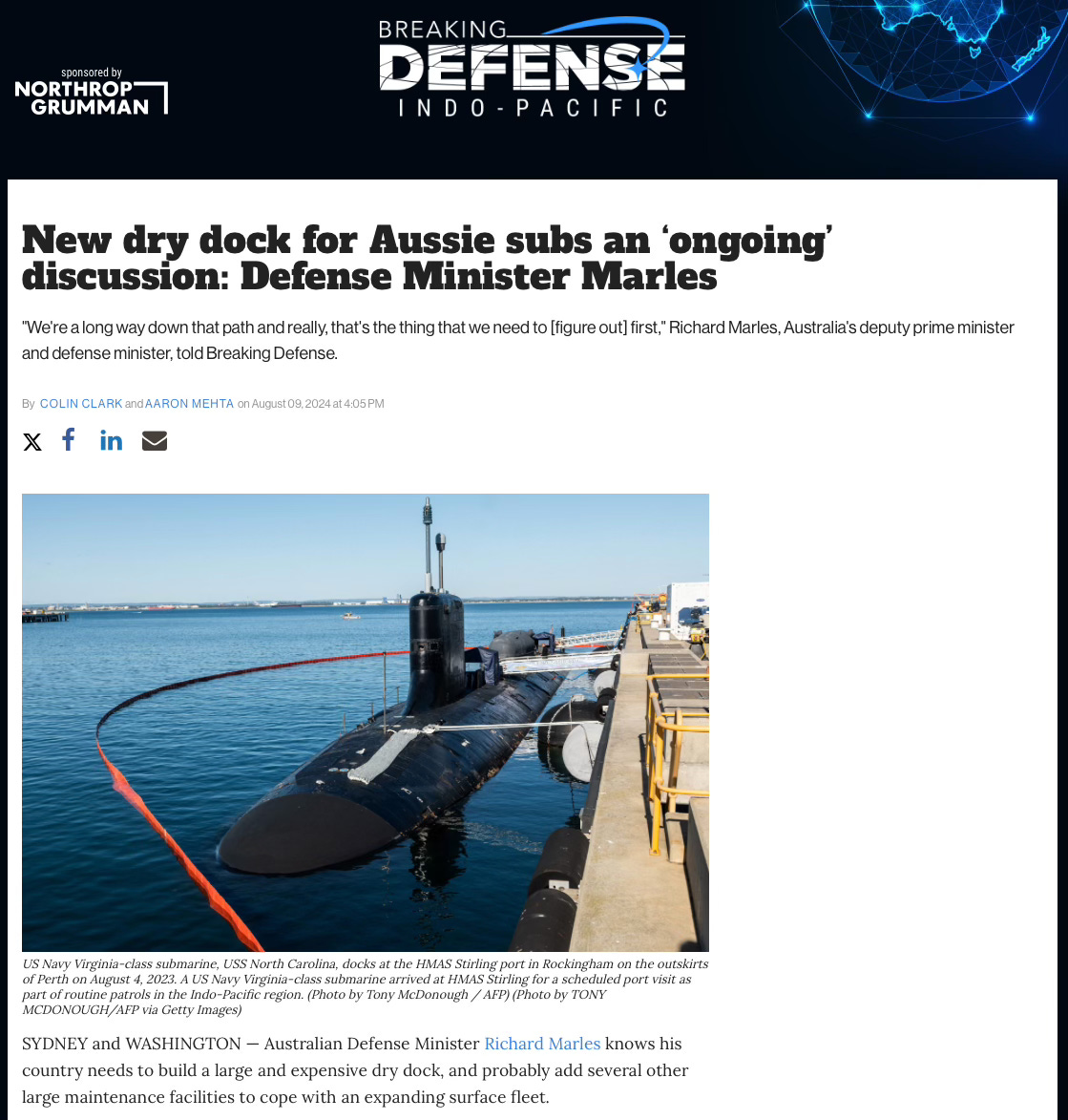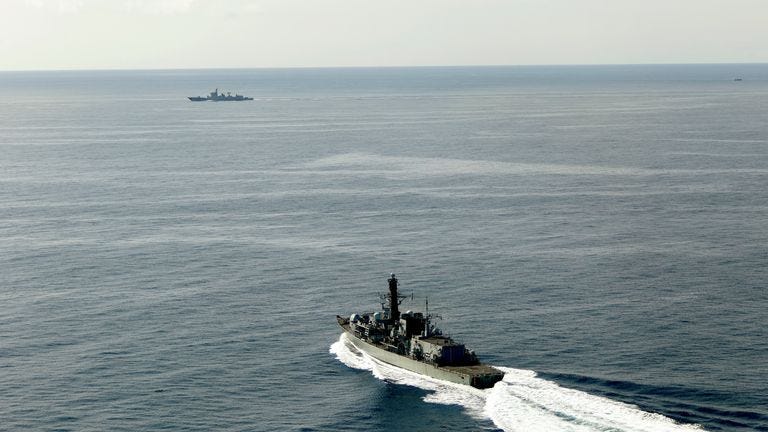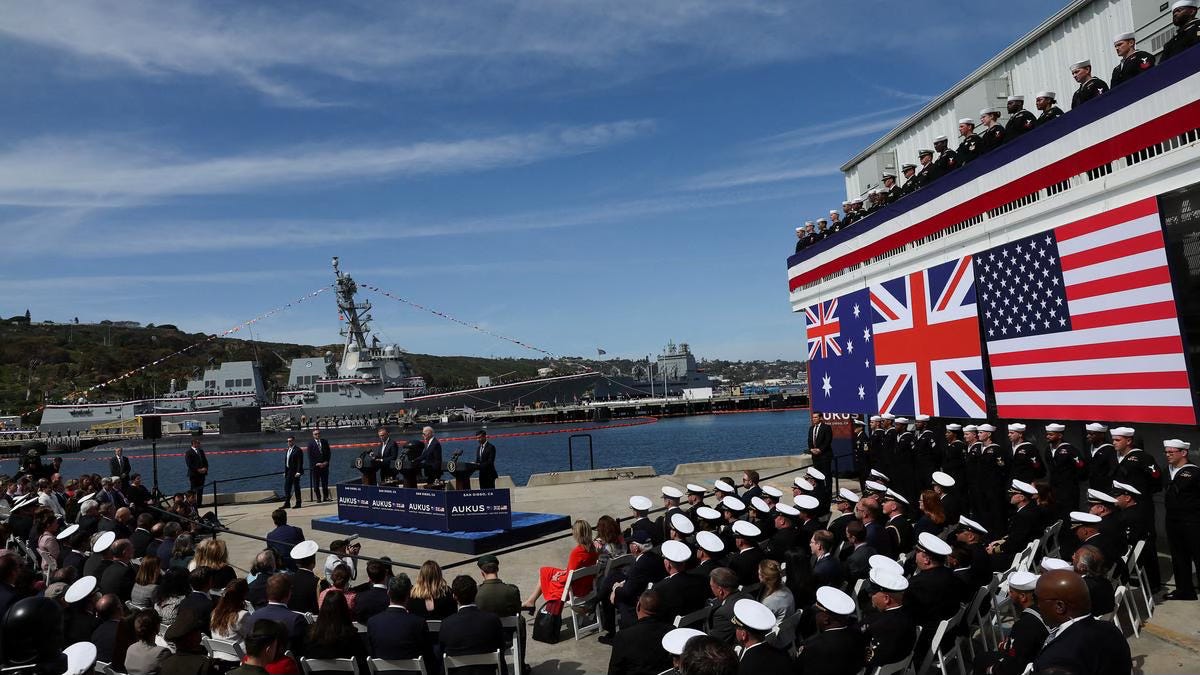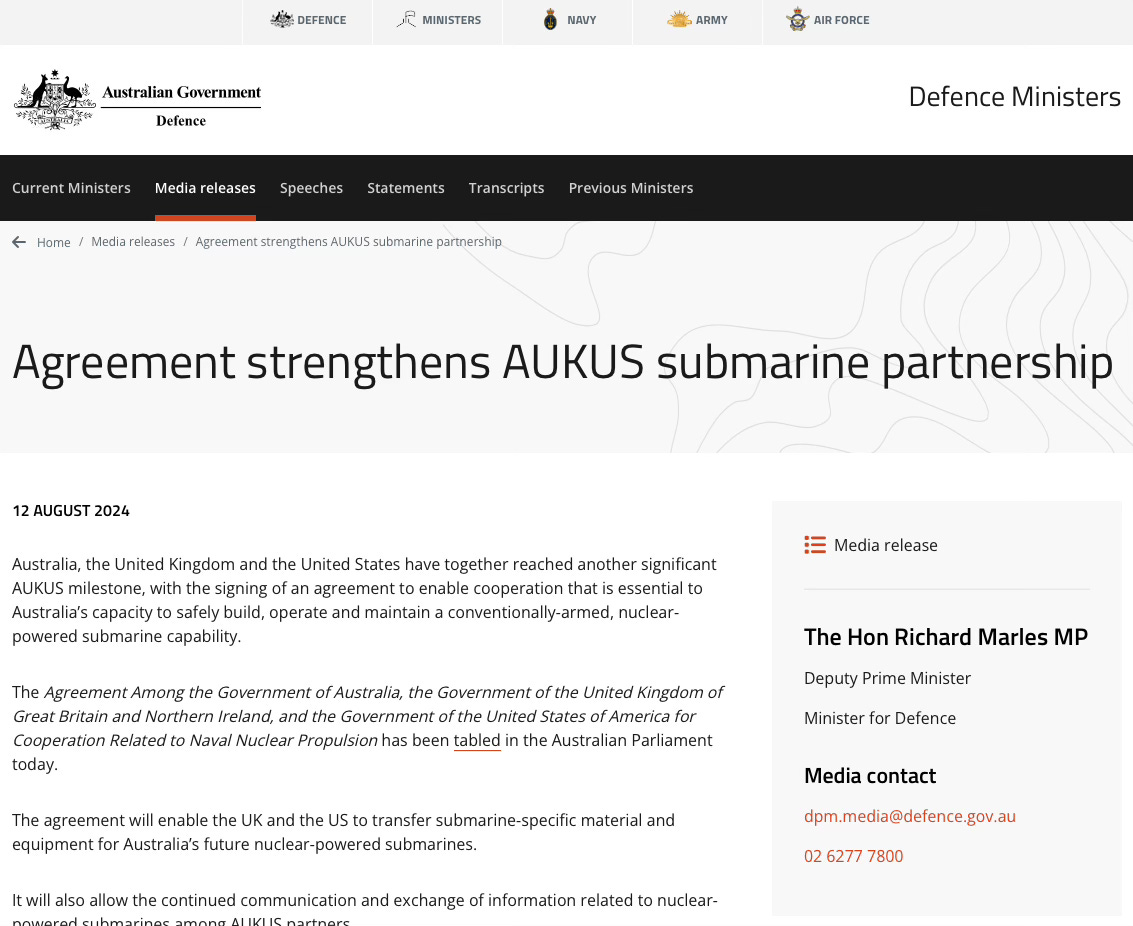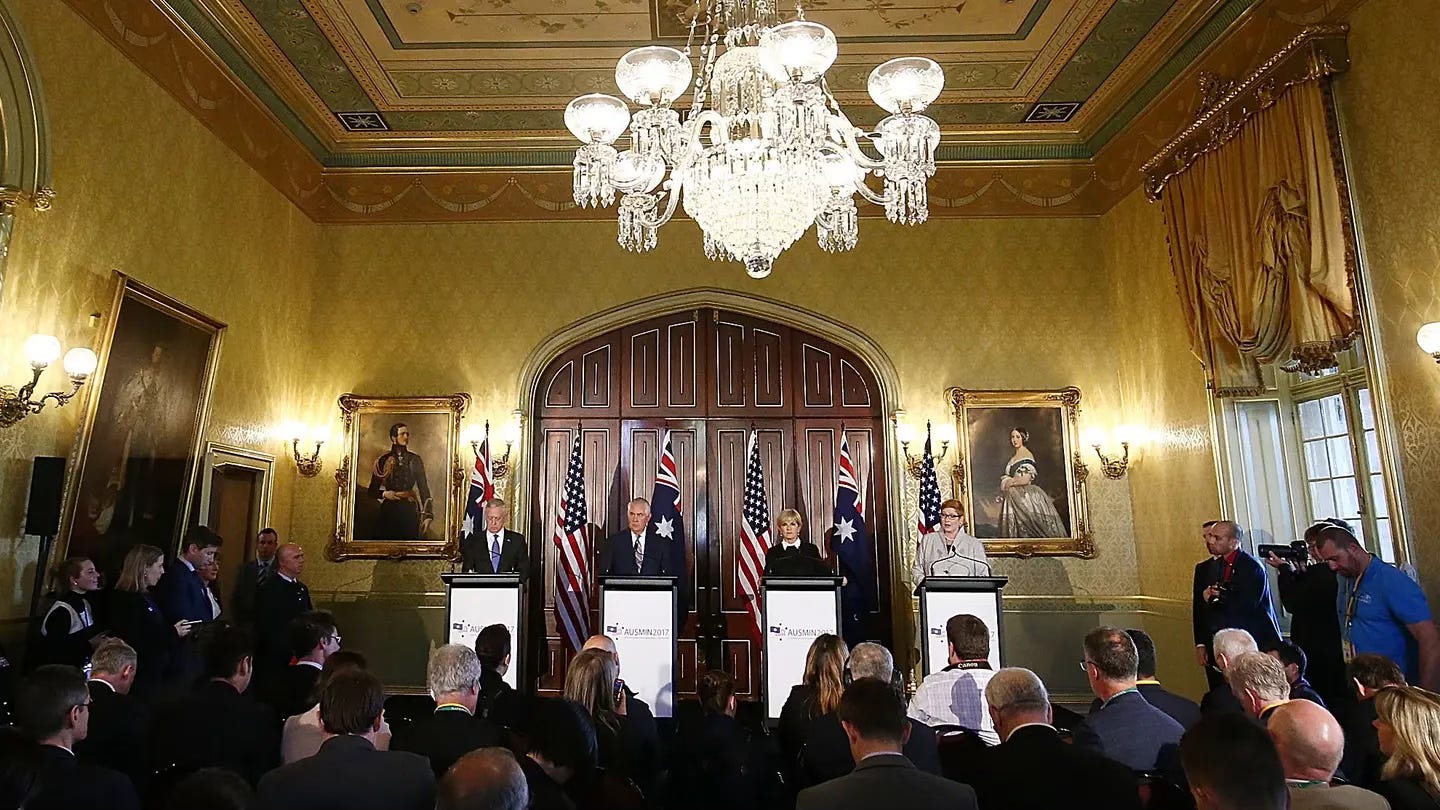AUKUS CLOCK
AUKUS agrees to get-out subs clause, New dry dock for Aussie subs?, Royal Navy watches Chinese warships travelling through UK waters, [Official] Agreement strengthens AUKUS submarine partnership.
AUKUS agrees to get-out subs clause
Documents tabled in parliament reveal the US and UK can walk away from a newly revamped AUKUS agreement, and will be indemnified against any loss or injury connected to nuclear waste.
What we know:
Under the new terms the US and UK could exit the AUKUS agreement to provide nuclear-powered submarines to Australia with a year’s notice (SBS);
The other countries can exit if assisting Australia poses an “unreasonable risk” to their own military needs (AFR $);
Australia would also foot the bill for any loss or injury from the disposal and storage of radioactive waste from nuclear submarines (ABC);
Details of the "understanding" signed by all three AUKUS partners last week in Washington, DC, have now been tabled in federal parliament, with the agreement to "remain in force until 31 December 2075”;
According to the document, “Australia shall be responsible for the management, disposition, storage, and disposal of any spent nuclear fuel and radioactive waste resulting from the operation of Naval Nuclear Propulsion Plants”;
The document leaves the transfer of reactors conditional on striking an agreement with the International Atomic Energy Agency, where China is trying to use the bureaucracy to thwart AUKUS;
Defence expert Hugh White last year warned that Australia may never actually get the AUKUS submarines as multiple points of failure are built into the program (The Saturday Paper);
It comes after Canada opted not to join the AUKUS arrangement, choosing a much cheaper non-nuclear submarine option instead (The Saturday Paper);
Meanwhile, an AI-enabled drone developed under AUKUS demonstrated the first use of autonomy and AI sensing systems in a real-time military environment to identify targets to be destroyed (The Engineer).
https://campaigns.schwartzmedia.com.au/t/i-e-fcydtk-tdtitihity-r/
New dry dock for Aussie subs an ‘ongoing’ discussion: Defense Minister Marles
"We're a long way down that path and really, that's the thing that we need to [figure out] first," Richard Marles, Australia's deputy prime minister and defense minister, told Breaking Defense.
By Colin Clark (Breaking Defense)
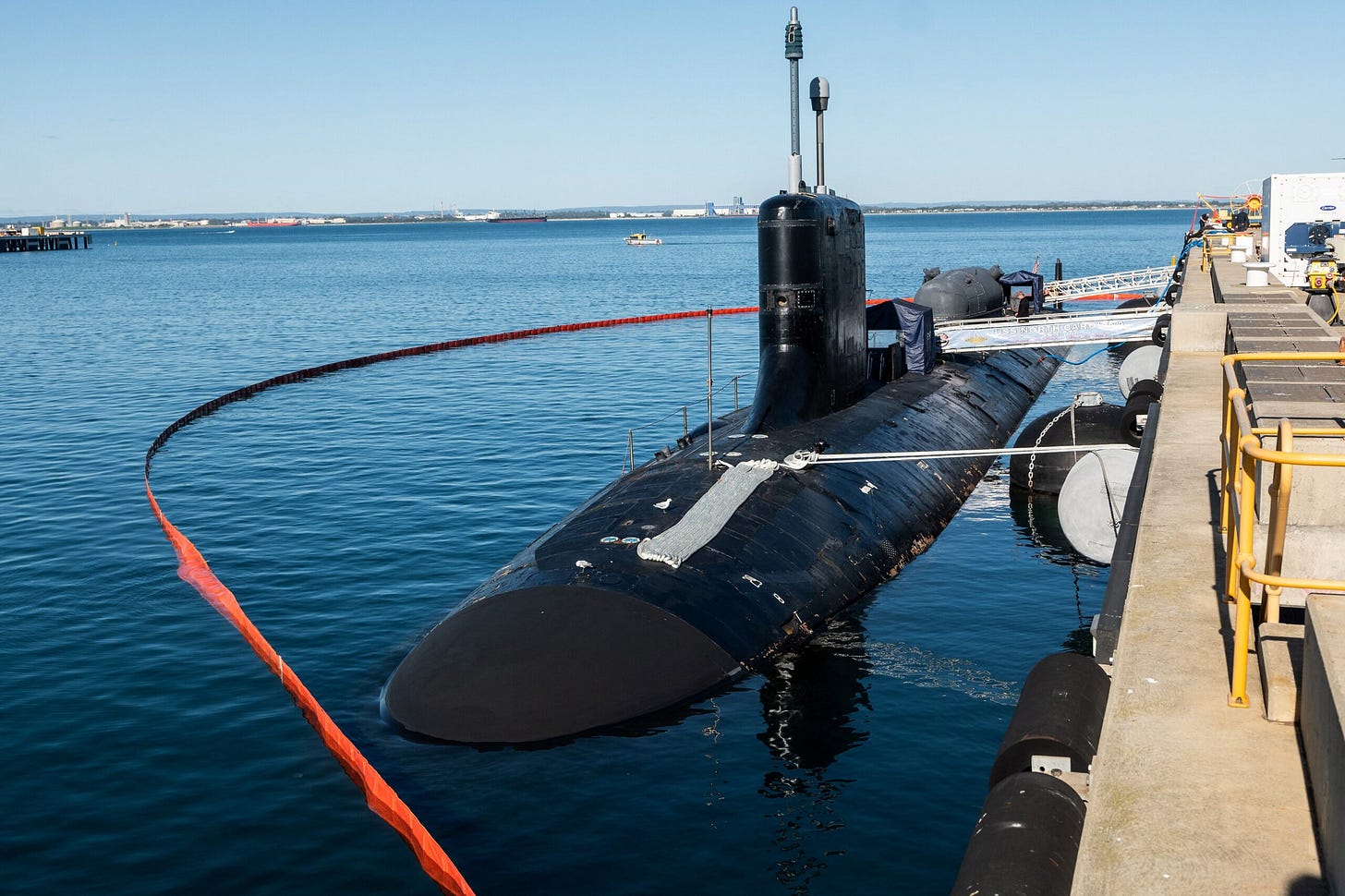
SYDNEY and WASHINGTON — Australian Defense Minister Richard Marles knows his country needs to build a large and expensive dry dock, and probably add several other large maintenance facilities to cope with an expanding surface fleet.
But just when it will begin construction, where it will be built and how much Australia will need to spend for what is likely to be a decade-long project appear to fall under what former US Defense Secretary Donald Rumsfeld called the “known unknowns.”
Asked when a decision about the dry dock project might be made, Marles did not provide a timeline, but told Breaking Defense during an exclusive Washington interview this week that, “We’re working very intensely on ensuring that there is the full capability of what we need in WA [Western Australia] to do the suite of maintenance that is required for the Virginia class submarines, both American and ours. And it’s an ongoing process.”
The Virginia and SSN AUKUS class subs will initially be based out of HMAS Stirling, the naval base near Perth, WA from which the conventionally-powered Collins-class subs operate today. But the goal is to eventually shift maintenance of its new SSNs to the town of Henderson, which is also where the Australian military’s new general general purpose frigates and amphibious landing craft fleet are being built.
The issue of building a large dry dock capable of servicing nuclear-powered subs, which are much larger and require much greater security than do conventional boats, was publicly raised last month at the Indian Ocean Defence and Security Conference, when Marles was asked when it would be built. He declined to answer on timeline then, and based on his comments both then and now, it appears that the scope of the decision — including deciding how many related facilities, such as a ship lift and new shipyard facilities at Henderson are needed — is impacting the speed of decision making.
Figuring out what’s needed at Henderson is the “first step” towards solving the challenge, Marles said in his interview this week.
“That’s been complicated, because it requires both the current commercial consolidation and physical consolidation. But we’re a long way down that path and really, that’s the thing that we need to [figure out] first. That then opens the door as to what that precinct will look like and what capabilities are there, but we absolutely got to make the capabilities which enable us to do this,” he said.
A source who asked not to be identified laid out some of the difficult choices Australia faces.
If Australia wants to do specific deep nuclear maintenance it needs at least one dry dock, but should have two for resilience, this source believes. The source added that having a floating dry dock big enough for a nuke boat for lower level maintenance would probably be needed, and none of that even addresses the choices that need to be made about accommodating the surface fleet at Henderson.
Marcus Hellyer, an acquisition expert with Strategic Analysis Australia, a new think tank here, said of the project, “there’s a level of complexity here that is far beyond anything defense has ever done.”
“We need to coordinate a whole bunch of decisions across the surface fleet, the subsurface fleet, the nuclear subsurface fleet and conventional subsurface fleet, across construction, across deep maintenance, across everyday maintenance– all of these different pieces,” Hellyer told Breaking Defense. “And guess what? They’re all in competition.”
Australia has been eager, Hellyer said, to demonstrate something is getting done. The Lucky Country has committed $4.6 billion AUD ($3 billion USD) to the UK to help build and design the SSN AUKUS fleet’s nuclear reactors and to design the subs. That came after Australia made the unprecedented decision to make a $3 billion investment in the US over the next five years for long-lead items and to help fund the expansion of American shipyards that will build and retrofit Australia-bound Virginia-class nuclear-powered attack subs.
Much of the public discussion about the AUKUS challenges has been cast by the government in positive terms — it’s going to be really hard, but Australians have done the near impossible before. But that doesn’t build dry docks or the extra housing needed or the much more secure facilities needed to protect nuclear secrets in Australia. For his part, Hellyer thinks the challenges, including sorting out the dry dock issue, need to be taken seriously.
“So, all this crap about, if we just say ‘Aussie, Aussie, Aussie!’ and, you know, remember the Harbour Bridge and the Sydney Opera House and the Snowy Mountain scheme and the spirit of Anzac, I mean, that’s just nonsense,” Hellyer said. “These things are in competition for a finite amount of resources. And the bottom line is, there simply are not enough resources. Even if you had all the money in the world, which they seem to do, there’s just not enough people, space, industrial capacity, head space in defense and the government to process all of these things.”
https://breakingdefense.com/2024/08/new-dry-dock-for-aussie-subs-an-ongoing-discussion-defense-minister-marles/
Royal Navy watches Chinese warships travelling through UK waters
The navy says it is not common for Chinese ships to transit through UK waters under the eye of the British and the last time it happened was in 2019.
By Deborah Haynes (SkyNews)
Two Chinese warships have travelled through UK waters closely watched by a British frigate in a rare transit, the Royal Navy has revealed.
HMS Richmond kept a "close watch" on the Chinese Navy task group as it passed the UK twice in three weeks, travelling to and from Russia.
Monitoring foreign warships is a routine operation for the navy but it is far more common for the Ministry of Defence to publicise the tracking of Russian ships rather than vessels deployed by the Chinese People's Liberation Army (Navy).
Armed Forces minister Luke Pollard said: "These escorts are a clear demonstration of how the Royal Navy continues to protect the sovereignty of UK waters.
"Working closely with our allies to support Euro-Atlantic security is a top priority for this government.
"I thank the crew of HMS Richmond for conducting a safe and professional transit and all they do in keeping our nation secure at home and strong abroad."
The British warship monitored China's Jiaozuo, a 7,500-tonne destroyer, and Honghu, a 23,400-tonne supply ship, as they made their journey back and forth through the North Sea and into the Channel.
A French warship and a patrol ship from the Belgian navy also shared the task of watching the Chinese vessels.
HMS Richmond's commanding officer, Commander Richard Kemp, said: "By maintaining a visible and persistent presence, the Royal Navy demonstrates our commitment to the NATO alliance and in maintaining maritime security which is crucial to our national interests."
The two Chinese ships initially passed through UK waters on the way to St Petersburg to take part in an annual event called Russian Navy Day at the end of July.
They then returned a couple of weeks later. The date of the return journey was not clear from the Royal Navy statement, released on Saturday.
The navy said it is not common for Chinese ships to transit through UK waters under the eye of the British.
The last time it happened was in 2019, when Chinese vessels made a similar journey to attend the same Russian naval event.
https://news.sky.com/story/royal-navy-watches-chinese-warships-travelling-through-uk-waters-13194469
Australia, U.S., U.K. sign nuclear transfer deal for AUKUS submarines
But Australia would be responsible for the storage and disposal of spent nuclear fuel and radioactive waste from the nuclear power units that are transferred under the deal
Published - August 12, 2024 09:21 pm IST - Sydney
https://www.thehindu.com/news/international/australia-us-uk-sign-nuclear-transfer-deal-for-aukus-submarines/article68516942.ece
Agreement strengthens AUKUS submarine partnership
Australia, the United Kingdom and the United States have together reached another significant AUKUS milestone, with the signing of an agreement to enable cooperation that is essential to Australia’s capacity to safely build, operate and maintain a conventionally‑armed, nuclear-powered submarine capability.
The Agreement Among the Government of Australia, the Government of the United Kingdom of Great Britain and Northern Ireland, and the Government of the United States of America for Cooperation Related to Naval Nuclear Propulsion has been tabled in the Australian Parliament today.
The agreement will enable the UK and the US to transfer submarine-specific material and equipment for Australia’s future nuclear‑powered submarines.
It will also allow the continued communication and exchange of information related to nuclear-powered submarines among AUKUS partners.
The agreement will be central to Australia’s acquisition of a sovereign nuclear-powered submarine capability from the 2030s, with the transfer of Virginia class submarines from the US to Australia, and the transfer of equipment from the UK for use in Australia’s SSN‑AUKUS submarines.
It will also enable Australia to prepare for Submarine Rotational Force-West at HMAS Stirling from 2027, supporting the rotational presence of up to four Virginia class submarines from the US and one Astute class submarine from the UK.
Consistent with the commitment of AUKUS partners, the agreement will see Australia uphold the highest standards for safety, security and non-proliferation.
Future SSN-AUKUS submarines will be built at Osborne in South Australia, using sealed, welded power units that will not require refuelling over the life cycle of the submarine.
Australia is committed to the global nuclear non-proliferation regime. The agreement expressly rules out enriching uranium or reprocessing spent nuclear fuel in Australia as part of AUKUS and prevents AUKUS partners undertaking any activity that would contravene international non-proliferation obligations.
Importantly, the agreement re-affirms, and is consistent with Australia’s international non-proliferation obligations, including under the Treaty on the Non-Proliferation of Nuclear Weapons, the South Pacific Nuclear Free Zone Treaty and our safeguards agreements with the International Atomic Energy Agency.
As a responsible nuclear steward, Australia will manage all waste generated by its own Virginia class and SSN-AUKUS submarines. Australia will not process spent nuclear fuel or reactors from the US, UK or other countries.
The agreement will replace the Exchange of Naval Nuclear Propulsion Information Agreement, which entered into force in 2022.
Quotes attributable to Deputy Prime Minister, the Hon Richard Marles MP:
“This agreement is an important step towards Australia’s acquisition of conventionally-armed, nuclear-powered submarines for the Royal Australian Navy.
“It builds on the significant progress that has already been achieved, including the passing of the US National Defense Authorization Act, the announcement of Australia’s sovereign submarine build and sustainment partners, and the ongoing work to integrate and uplift the industrial bases of all three AUKUS partners.
“The Albanese Government, alongside AUKUS partners, continues to re-affirm that Australia’s acquisition of conventionally-armed, nuclear-powered submarines will set the highest non-proliferation standards through the AUKUS partnership. The agreement is unequivocal that, as a non-nuclear weapons state, Australia does not seek to acquire nuclear weapons.”
MEDIA NOTE:
Media can access imagery at: http://images.defence.gov.au/S20242346
https://www.minister.defence.gov.au/media-releases/2024-08-12/agreement-strengthens-aukus-submarine-partnership
Explainer: A brief history of AUSMIN
By United States Study Centre (Sydney, Australia)
The Australia-United States Ministerial Consultations (AUSMIN) are Australia’s principal forum for formal consultations with the United States. The talks are led by the Australian Foreign and Defence Ministers and their counterparts, the US Secretaries of State and Defence. In addition to these ‘principals’, other regular attendees include Australia’s Chief of Defence Force, Director-General of the Office of National Assessments, the Secretaries of DFAT and Defence and Ambassador to the United States. They are typically joined by the Commander of US Pacific Command (PACOM), the Director of National Intelligence (DNI), the US Assistant Secretaries for East Asia and the Pacific at both State and Defense, and the US Ambassador to Australia.
The 2018 AUSMIN Consultation in Palo Alto will be the 28th in 33 years (it is supposed to be an annual event). AUSMIN has existed in its current form since 1985, following New Zealand’s refusal to allow US nuclear submarines into its ports that year and the United States’ subsequent suspension of its ANZUS security commitment to Wellington. Past AUSMIN forums have included many formal resolutions strengthening the US-Australia security alliance, including the Sydney Statement (1996), the Memorandum of Understanding on Ballistic Missile Defense (2004), the Space Situational Awareness Partnership (2010), and the US Force Posture Agreement(2014).
AUSMIN 2018, Palo Alto
Principals: Julie Bishop/Marise Payne, Mike Pompeo/James Mattis
AUSMIN 2018 will be the second such meeting between the Trump and Turnbull administrations and the first meeting of Foreign Minister Julie Bishop and Secretary of State Mike Pompeo. It will commemorate ‘100 Years of Mateship’ between the two nations following the 100th anniversary of the World War I Battle of Hamel. This year’s AUSMIN marks only the fourth consultation in the US to be held outside Washington’s beltway, at Stanford University’s Hoover Institution (incidentally, where James Mattis served as a Distinguished Visiting Fellow until being confirmed as the 26th Secretary of Defense). The talks will focus on deepening the strategic alliance and further developing a shared vision of peace, stability, and prosperity in a 'free and open' Indo-Pacific. Bolstering efforts to counter China’s strategic assertiveness and economic diplomacy in the region will feature as a priority issue. This may include discussions on Australian contributions to maritime patrols in the South China Sea, and operationalising joint economic and infrastructure initiatives with India and Japan tentatively flagged in February. Both countries will reaffirm their shared commitment to principles of freedom of navigation and overflight, the value of the rules-based order, and deepening cooperation with likeminded regional partners, particularly in the Pacific. They will also likely hail the recent diplomatic breakthroughs with North Koreaand encourage Pyongyang to abide by its stated commitment to pursue peace and denuclearisation on the Korean Peninsula. Both countries will likely reiterate their ongoing commitment to countering violent extremism in Afghanistan, Iraq, the Philippines and Indonesia. The ongoing absence of a US ambassador to Australia may also be addressed.
AUSMIN 2017, Sydney
Principals: Julie Bishop/Marise Payne, Rex Tillerson/James Mattis
AUSMIN 2017 was the first with the Trump administration. The two sides celebrated the alliance by remembering the 75th anniversary of the Battle of the Coral Sea and the 50th anniversary of the Joint Defence Facility at Pine Gap.. Australian and American representatives reiterated their continued contribution to Afghan security and the global coalition against ISIS. They underlined shared commitment to a safe and secure Indo-Pacific through regional organisations like the East Asia Summit, APEC and ASEAN Defence Ministers’ Meeting, and underlined the importance of upholding the principles of freedom of navigation and overflight and the value of the rules-based order. Both countries expressed concern over North Korea’s nuclear capabilities and the threat it posed to the region, and committed to deeper engagement with regional partners as well as pledging to strengthen trilateral cooperation with Japan.
AUSMIN 2015, Boston
Principals: Julie Bishop/Marise Payne, John Kerry/Ash Carter
Concerns over Chinese land reclamation in the South China Sea, the rise of ISIS, and the conflict in Syria dominated talks at AUSMIN 2015. Australian and American representatives called on East Asian governments to abide by the United Nations Convention on Law of the Sea (UNCLOS), reiterated their commitment to the collective defence of Iraq, and called on Russia to cease its attacks on the Syrian opposition. Both parties expressed their support for the Joint Comprehensive Plan of Action between the P5+1 and Iran, and agreed to work towards international agreements on climate change and refugee challenges. The security relationship was further deepened with the signing of a Joint Statement on Defense Cooperation and the Joint Border Protection Initiative. Both countries also reiterated their shared intent to conclude the Trans-Pacific Partnership.
AUSMIN 2014, Sydney
Principals: Julie Bishop/David Johnston, John Kerry/Chuck Hagel
The Joint Statement issued after AUSMIN 2014 reflected the disappointment and condemnation shared by Australian and American representatives at several key international incidents: Russia’s interference in Ukraine and its annexation of Crimea, North Korea’s erratic behaviour, the humanitarian and political crisis in Syria, and the rise of ISIS. The US and Australia subsequently signed a Force Posture Agreement to fully implement the Force Posture Initiatives in Australia. This involved enhanced aircraft and naval cooperation and the interoperability of Special Forces. They also agreed on an increased US Marine Corps presence and reaffirmed a strong commitment to conclude the Trans-Pacific Partnership. In line with the increased awareness of space and cyber threats, both countries reaffirmed their commitment to practical space cooperation, defence science and technology, and the application of international law in cyberspace.
AUSMIN 2013, Washington D.C.
Principals: Julie Bishop/David Johnston, John Kerry/Chuck Hagel
The US and Australia highlighted the importance of abiding by international law at AUSMIN 2013. Ministers agreed to enhance common understandings on norms of responsible behaviour in cyberspace and continued to emphasise the importance of respect for freedom of navigation in the South China Sea. Denuclearising North Korea and Iran was a priority, while there was also a call for the convening of the Geneva II conference to end the conflict in Syria. Ministers issued a Joint Statement of Principles on US Force Posture Initiatives in northern Australia and agreed to implement rotational US Marine Corps deployments and Air Force rotations. They also signed a Memorandum of Understanding governing the arrangements for the US telescope and C-Band space surveillance radar to Western Australia. Both countries agreed to finalise an International Code of Conduct for Outer Space Activities. The United States and Australia reaffirmed their intent to conclude a high-standard and comprehensive Trans-Pacific Partnership.
AUSMIN 2012, Perth
Principals: Bob Carr/Stephen Smith, Hillary Clinton/Leon Panetta
The most concrete outcomes of AUSMIN 2012 were the enhancement of US-Australia military, communications, and economic cooperation. Both countries recognised the success of the first rotation of US Marine Corps personnel in northern Australia, before signing a Memorandum of Understanding on the relocation and establishment of a jointly-operated US C-Band space surveillance radar at the Harold E. Holt Naval Communication Station in Western Australia in 2014. Ministers also agreed to work towards the relocation of a US Space Surveillance Telescope to Australia and the possible establishment of a Combined Communications Gateway. These outcomes aligned with the shared desire to develop a common understanding on the international norms of cyberspace. Delegates on both sides resolved to conclude a Trans-Pacific Partnership.
AUSMIN 2011, San Francisco
Principals: Kevin Rudd/Stephen Smith, Hillary Clinton/Leon Panetta
AUSMIN 2011 marked the 60th anniversary of the ANZUS Treaty. Both countries maintained their stance on the need for freedom of navigation in the South China Sea and reiterated the importance of the East Asia Summit, which now included the participation of the United States. Ministers resolved to work towards a successful conclusion of the Trans-Pacific Partnership. They also continued their support for the full implementation of UN Resolutions on Iran and called for Syrian President Assad to step aside. The continued concern over cyberspace culminated in a Joint Statement on Cyberspace. Meanwhile, both countries supported efforts to develop a US-Australia Combined Communications Partnership and to strengthen the AusAID-USAID partnership.
AUSMIN 2010, Melbourne
Principals: Kevin Rudd/Stephen Smith, Hillary Clinton/Robert Gates
AUSMIN 2010 resulted in some of the most comprehensive developments in the US-Australia security relationship. Ministers signed a Space Situational Awareness Partnership and issued a Joint Statement on Space Security in response to concerns over space as an increasingly contested military arena. These complemented the preparation for ratifying a Naval Communication Station in Western Australia. The two countries also signed the Australia-US Defence Trade Cooperation Treaty, established a Memorandum of Understanding on cooperation between AusAID and USAID, and created a partnership to address violence against women globally. Regionally, both countries affirmed the need for peaceful resolution to maritime territorial disputes in the South China Sea and supported freedom of navigation and a binding Code of Conduct. The promotion of a secure and resilient cyberspace was also a priority.
AUSMIN 2009, Washington D.C.
Principals: Stephen Smith/Joel Fitzgibbon, Hillary Clinton/Robert Gates
Following America’s strategic policy review of Afghanistan and Pakistan, Ministers at AUSMIN 2009 discussed curbing the ability of al-Qaida, reconstructing Afghanistan, and working with the democratic government in Pakistan. While concerns continued over Iran’s nuclear activities and North Korea’s long-range missile test, American and Australian principals lauded regional developments including China’s constructive role in addressing the global financial and economic crisis and India’s progress in strengthening its democracy. They also underlined the importance of continued trilateral cooperation with Japan. While there were fewer notable joint agreements than in past consultations, both countries did agree on principles for enhancing intelligence collaboration and, for the first time, cyber security cooperation.
AUSMIN 2008, Canberra
Principals: Stephen Smith/Joel Fitzgibbon, John Negroponte (Deputy)/Robert Gates
At AUSMIN 2008, principals expressed joint support for negotiations between Israel and the Palestinian Authority and shared concern over the political impasse in Lebanon. Both countries continued to push for a democratic Iraq and Afghanistan and remained concerned over a potentially nuclear Iran. Regionally, principals resolved to advance shared interests with democratic India and warmly welcomed Thailand’s return to democratic government. Close US-Australia military cooperation continued with progress in the US-Australia Treaty on Defence Trade Cooperation, the signing of a Statement of Principles establishing a military satellite communications partnership, and welcoming the forthcoming Exercise Talisman Sabre in 2009. The countries also agreed to establish an investment program to develop a Humanitarian Assistance/Disaster Relief capability.
AUSMIN 2006, Washington D.C.
Principals: Alexander Downer/Brendan Nelson, Condoleezza Rice/Gordon England (Dep)
Ministers at AUSMIN 2006 responded to new regional challenges by condemning North Korea’s nuclear test in October 2006, expressing their concern over instability in Pacific Island states, welcoming Indonesia’s growing regional role, and expressing their desire to see China play a role as a responsible member of the international community. Both countries agreed that the North Korean and Iranian missile tests in 2006 reinforced the need to intensify US-Australia cooperation under the Memorandum of Understanding on Missile Defence, as well as enhancing cooperation in intelligence and surveillance. Additionally, the two sides signed a Memorandum of Understanding on the Production, Sustainment, and Follow-on Development of the Joint Strike Fighter.
AUSMIN 2005, Adelaide
Principals: Alexander Downer/Robert Hill, Robert Zoellick (Dep)/Donald Rumsfeld
Outcomes of AUSMIN 2005 reflected the weight that Australia and the US attributed to confronting security challenges in a bilateral manner. These included signing the Joint Combined Training Centre Memorandum of Understanding, the agreement on Enhancing Regional Peace Operations Capability, and the Strategic Bombing Training Program. These agreements were signed following continued security concerns in Afghanistan and Iraq, as well as incidents including recent terrorist attacks in London, Bali, and Amman. Australia and the US also agreed on the need for a Trilateral Security Dialogue with Japan and welcomed the progress of the Six-Party talks which promoted nuclear non-proliferation in North Korea.
AUSMIN 2004, Washington D.C.
Principals: Alexander Downer/Robert Hill, Colin Powell/Donald Rumsfeld
AUSMIN 2004 was the first AUSMIN during the Iraq War and featured discussions on procedures to transfer sovereignty to the Iraqi Interim Government. Both countries noted the continued threat of terrorism and the threat of terrorists acquiring weapons of mass destruction, while in the Asia-Pacific region talks revolved around the strengthening of US military capabilities following its Global Force Posture Review. The countries signed a Memorandum of Understanding on Ballistic Missile Defence and agreed on a Joint Combined Training Centre in Australia. They supplemented these agreements with a Joint Statement of Principles on Interoperability, further underlining the shared desire for enhanced military cooperation.
AUSMIN 2002, Washington D.C.
Principals: Alexander Downer/Robert Hill, Colin Powell/Donald Rumsfeld
The Global War on Terrorism was high on the agenda at AUSMIN 2004 following the terrorist attacks on the US on September 11, 2001 and the Bali bombings on October 12, 2002. The Joint Statement outlined the reaffirmation of US-Australia support for the Global War on Terrorism, particularly the effort to bring peace and democracy to Afghanistan. Principals welcomed APEC’s counterterrorism initiatives and the contributions of India and Pakistan to the Global War on Terrorism. Both sides sought to enhance cooperation through the ongoing Interoperability Review and the Joint Strike Fighter program, and resolved to work towards laying the foundation for a Free Trade Agreement.
AUSMIN 2001, Canberra
Principals: Alexander Downer/Peter Reith, Colin Powell/Donald Rumsfeld
US and Australian representatives emphasised the enduring relevance of the alliance for regional stability on the 50th anniversary of the ANZUS Treaty. Ministers continued to highlight the importance of Indonesia for the stability and prosperity of South East Asia, while Australia noted the significance of the US-Japan alliance which also marked its 50th anniversary. In the Joint Statement, principals agreed to undertake a top-down review of interoperability as well as a ten-year extension of the Australia-US Cooperative Defence Logistics Support Agreement. Australia and the United States noted their intention to cooperate to launch a new round of multilateral trade negotiations ahead of the WTO Ministerial Conference in Doha in November 2001.
AUSMIN 1999, Washington D.C.
Principals: Alexander Downer/John Moore, Madeline Albright/William Cohen
Principals at AUSMIN 1999 made a point of recognising the importance of Indonesia’s continued transition to democracy and its decision to take steps in giving East Timor its independence. Both countries expressed concern over tensions between India and Pakistan and the threat of terrorism in the lead-up to the Sydney 2000 Olympics. In a rare expression of unilateral concern, Australia noted its disappointment at the failure of the US Senate to ratify the Comprehensive Test Ban Treaty (CTBT). Despite this, principals shared a desire for the continuation of the non-proliferation agenda, including the need for Iraq to fully comply with all relevant UN Security Council resolutions regarding the destruction of its weapons of mass destruction capabilities. The Joint Statement also noted the successful ‘Crocodile ‘ US-Australia joint exercise in Queensland in October 1999.
AUSMIN 1998, Sydney
Principals: Alexander Downer/Ian McLachlan, Madeline Albright/William Cohen
AUSMIN 1998 focused on measures to further Australian and US economic interests and stabilise the Asia-Pacific following the Asian Financial Crisis. Australian and US representatives supported the role of the IMF, World Bank, APEC, and the Asian Development Bank in promoting free trade and opening regional markets. The Joint Communiqué also detailed shared concern over India’s and Pakistan’s nuclear tests, the importance of international frameworks and the urgency of the START II Treaty entering into force. The two countries also established an AUSMIN Defence Acquisition Committee to coordinate operations and signed a 10-year extension of the treaty governing the Joint Defence Facility at Pine Gap.
AUSMIN 1996, Sydney
Principals: Alexander Downer/Ian McLachlan, Warren Christopher/William Perry
AUSMIN 1996 culminated in a Joint Security Declaration known as the Sydney Statement. The meeting aimed to ensure America’s continued presence in the Asia-Pacific region through forward-deployed forces, continued close cooperation in intelligence, and a commitment to joint military exercises and operations such as Pine Gap. Ministers agreed on the need to prevent the proliferation of weapons of mass destruction by enforcing international frameworks including the Comprehensive Test Ban Treaty, the Chemical Weapons Convention, and the Biological Weapons Convention. They also sought to continue development of strong bilateral relationships with Asia Pacific countries and regional forums including ASEAN and APEC.
AUSMIN 1985-1995
The AUSMIN Consultations prior to 1996 took place in:
1995, Washington D.C. (Gareth Evans/Robert Ray; Warren Christopher/William Perry)
1994, Canberra (Gareth Evans/Robert Ray; Warren Christopher/William Perry)
1992, Washington D.C. (Gareth Evans/Robert Ray; Lawrence Eagleburger/Paul Wolfowitz (Deputy))
1990, Washington D.C. (Gareth Evans/Robert Ray; James Baker/Richard Cheney)
1989, Sydney (Gareth Evans/Kim Beazley, James Baker/Richard Cheney)
1988, Washington D.C. (Bill Hayden/Kim Beazley, George Shultz/Frank Carlucci)
1987, Sydney (Bill Hayden/Kim Beazley, George Shultz/Caspar Weinberger)
1986, San Francisco (Bill Hayden/Kim Beazley, George Shultz/ Caspar Weinberger)
1985, Canberra (Bill Hayden/Kim Beazley, George Shultz/Admiral Crowe)
Details about agreements made at these consultations are not readily available.
Prepared by Ryan Hawkins, Research Intern, Alliance 21 Program.




